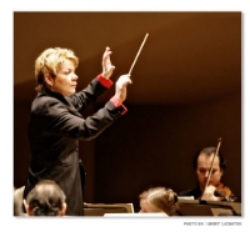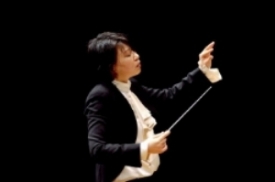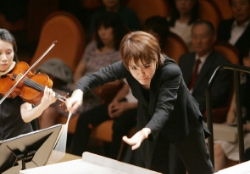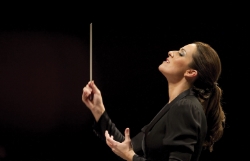THE RISE OF THE FEMALE CONDUCTOR
One of the outstanding trends over the past thirty years is the strides that women have made in gaining education and skills, allowing them to enter many new fields with high qualifications. With some success, women have been able to penetrate many of the world’s symphony orchestras too. However, there has long been resistance, especially in Europe, to the idea that female musicians could gain the ultimate prize: an appointment as Principal Conductor and Music Director of a major orchestra. Indeed, it was not that many years ago that the illustrious Herbert von Karajan resigned from the Berlin Philharmonic over the orchestra’s refusal to allow the appointment of a single female instrumentalist: clarinetist Sabine Meyer. And up to only a decade ago, the Vienna Philharmonic simply did not accept female appointments at any position.
Simone Young
JoAnn Falletta
Marin Alsop
Tania Miller
According to many musicians, prejudice still remains – but things have dramatically changed! More and more young female conductors are arriving from all over the world and there are now international conducting competitions for women. A symbolic turning point was probably the appointment of JoAnn Faletta (b.1954) as Principal Conductor of the Buffalo Philharmonic in 1999 and then Marin Alsop (b.1956) as Principal Conductor of the Bournemouth (U.K.) Symphony in 2003 and the Baltimore Symphony in 2007. All are distinguished orchestras with long histories and both American maestros have since had enterprising and successful recording careers. Equally important, Australian Simone Young (b.1961) became the first woman to ever conduct at the Vienna State Opera, to appear with the Vienna Philharmonic (2005), and to record Wagner’s ‘Ring’ cycle. She currently holds chief director positions with both the Hamburg Philharmonic and the Hamburg State Opera. Even closer to home, Saskatchewan-born Tania Miller (b.1969-) enters her 10th season with the Victoria Symphony after serving as Associate Conductor of the Vancouver Symphony.
Most of the above conductors have toiled for years before achieving strong recognition and are certainly not ‘young’ any more. But they have broken the barrier at the top, allowing this generation of young female musicians to see conducting as an exciting and viable career choice.
Wing-sie Yip
This new trend should not obscure the fact that there have been significant female conducting contributions historically. Usually these have involved positions at the choral or chamber orchestra level, or guest conducting posts. Famed French composer and teacher Nadia Boulanger (1887-1979) was likely the first woman to ever direct major orchestras, including the Boston Symphony, New York Philharmonic and the BBC Symphony, giving world premieres of works by both Stravinsky and Copland in the late 1930’s. Moving to the English tradition, one must not forget Imogen Holst (1907-1984), daughter of the composer Gustav Holst, who spent many years conducting and recording her father’s own choral compositions. She also wrote the famous reference book, ‘Conducting a Choir: A Guide for Amateurs’. Iona Brown (1941-2004) directed the illustrious Academy of St. Martin’s-in-the-Fields from the late 1970’s, eventually taking appointments as director of the Norwegian Chamber Orchestra and the Los Angeles Chamber Orchestra, and guest director of the City of Birmingham Symphony Orchestra. Jane Glover (b.1949) served as principal conductor of the Huddersfield Choral Society and, from 1984-1991, of the London Mozart Players, making a number of distinguished recordings. Sian Edwards (b.1959) was the first female conductor to conduct an opera at Covent Garden, London (1988) and served as director of the English National Opera from 1993-95. She has guest conducted many top U.S and European orchestras.
As far as Asian female conductors go, there are indeed conductors that figure back in local musical folklore, but it is the Asian soloists (mainly violinists) who had the first chance at penetrating the West, starting from about 1970. One unique story is that of conductor Wing-sie Yip (b.1960), who moved, seemingly without a hitch, from a distinguished education in London and the U.S. to become Resident Conductor of the Hong Kong Philharmonic in 1986 at age 26. Holding this position until 2000, along with a Principal Conductor appointment at the Guangzhou Symphony, she has been Music Director of the Hong Kong Sinfonietta since 2002. This artist has been a truly active force in Asia’s musical life for the past two decades, conducting almost all Asian orchestras and in France, and recording for both Naxos and Decca. (See interview)
Xian Zhang
A more recent Chinese conductor of clear promise is Xian Zhang (b.1973). She won the Lorin Maazel Conducting Competition in 2002 and now directs the Orchestra Sinfonica di Milan Giuseppe Verdi. Just ending her tenure as Associate Conductor, New York Philharmonic, she and her Milan orchestra were honoured with an appearance in the closing concerts of the BBC Proms 2013. Another to watch is energetic Taiwanese/American Mei Ann Chen (b.1974), who became music director of the Nashville Symphony in 2010 (see VSO concert review 2013.)
Three young female conductors also form a strong part of South Korea’s musical base. Shi- Yeon Sung (b.1975) born in Pusan and trained in Germany, was the winner of the Sir Georg Solti International Conducting Competition in 2006 and is already conducting in international concert halls and opera houses with acclaim. She served as Assistant Conductor of the Boston Symphony Orchestra in 2010 and has been Associate Conductor of the Seoul Philharmonic since 2009. Han-Na Chang (b.1982), child protégé and internationally-renowned cellist, turned to conducting in 2007 with the aim of bringing classical masterpieces to the young. Progressing very quickly, Chang made her London debut with the Philharmonia Orchestra in 2012 and will appear with the famed Dresden Staatskapelle in 2013/14. Finally, Bong-Me Kim, also trained in Germany, is a conductor of clear potential with a strong interest in opera.
Alondra de la Parra
Left: Shi-Yeon Sung, Right: Han-na Chang
Given the increased number of accomplished classical musicians of South and Latin American origins emerging these days, it is not surprising female conductors are among them. One such is Mexican/American Alondra de la Parra (b.1980) who already shows clear command and distinction (see VSO concert review, November 2012).
Mirga Gražinytė-Tyla
Susanna Mälkki
The Los Angeles Philharmonic appointed Mirga Gražinytė-Tyla (b. 1986) as its new Assistant Conductor, and showcased both her and Susanna Mälkki (b.1969) in 2015 concerts. The former is Lithuanian; the latter is Finnish. In July 2015, Gražinytė-Tyla first guest-conducted the City of Birmingham Symphony Orchestra (CBSO), and was enthusiastically re-engaged six months later. In February 2016, the CBSO named her as its next music director, effective September 2016, with an initial contract of 3 years. She is the first female to be named music director of CBSO. Mälkki was director of Paris’ Ensemble Intercontemporain until 2013, and has recently been named to succeed John Storgårds as Music Director of the Helsinki Philharmonic Orchestra. These are both very important appointments.
But this is just the top of the iceberg. For the explosion in female conductors, I can do no better than refer you to http://musicloversblog.com/fanfare-for-the-uncommon-woman-conductor/ that lists almost 100 promising female conductors from around the world to look up. I assure you there are many more to come!
© Geoffrey Newman 2012
Partially Updated










